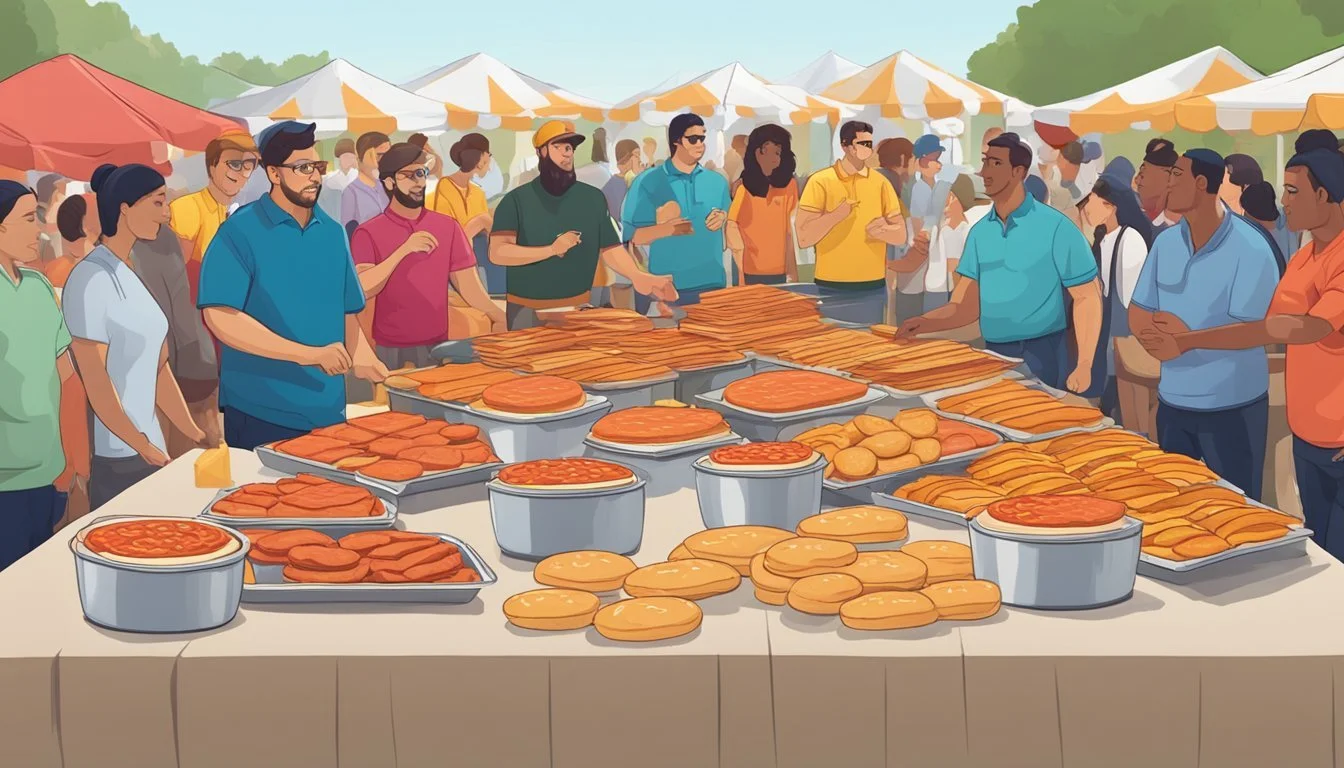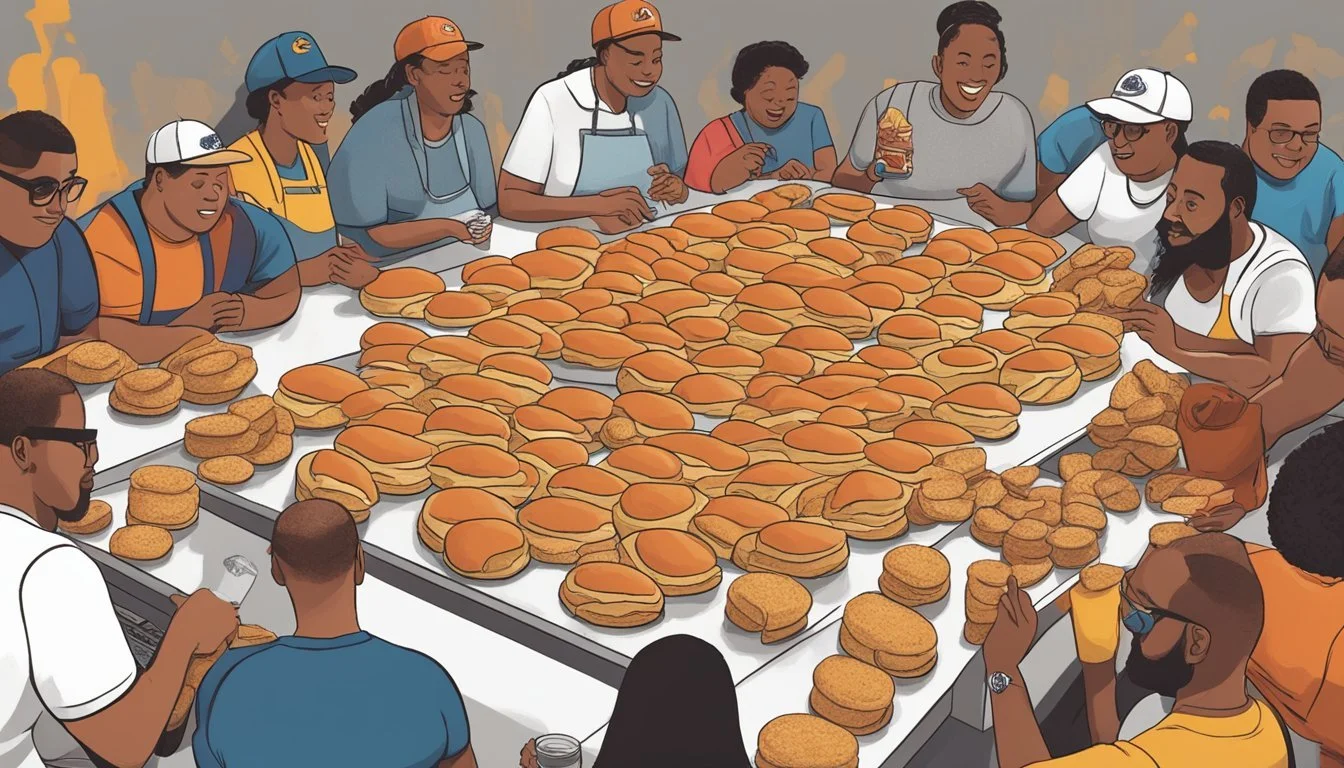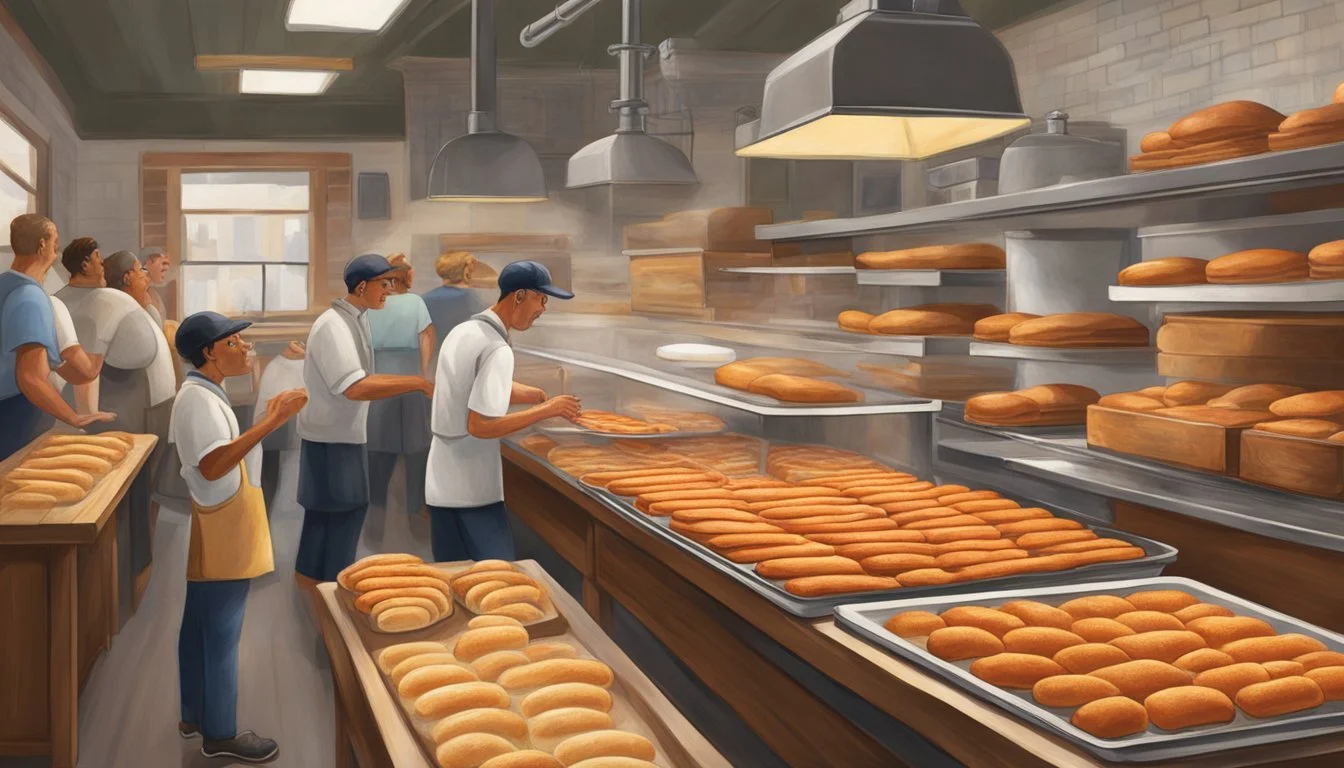West Virginia: The Pepperoni Roll Challenge
A Culinary Quest for Foodies
West Virginia holds a cherished position in the American culinary landscape, with its state food—the pepperoni roll—embodying a storied tradition. This simple yet savory snack consists of soft bread dough wrapped around pepperoni, a testament to the ingenuity of the state's Italian immigrant coal miners who needed a hearty, portable lunch (What wine goes well with lunch?). Over generations, it has evolved from a miner’s midday meal into a cultural symbol of West Virginia's heritage and community.
The pepperoni roll's humble beginnings in North-Central West Virginia are rooted in practicality, yet it has risen to prominence, captivating the taste buds of residents and titillating the curiosity of food enthusiasts from afar. Across the state, bakeries and family kitchens have honed their recipes, each contributing to the rich tapestry of variations on the classic pepperoni roll, which range from the addition of cheeses to the incorporation of spicy or sweet pepperoni.
Today, the Pepperoni Roll Challenge encapsulates this diversity, inviting both locals and visitors to weave their way through West Virginia's towns and taste the different iterations of this iconic fare. The endeavor not only showcases the creativity embedded in state's culinary fabric but also reaffirms the pepperoni roll's status as a symbol of West Virginia's gastronomic identity—maintained through generations, embraced by the community, and celebrated by food lovers everywhere.
Historical Significance of the Pepperoni Roll
The pepperoni roll stands as a testament to West Virginia's culinary ingenuity and the tight-knit history between its coal mining heritage and food culture. This portable dish is not just sustenance, but a symbol of the state's resourcefulness and endurance through time.
Origins in the Coal Mines
The creation of the pepperoni roll can be directly linked to the needs of coal miners in Appalachia during the early 20th century. Italian immigrants, working in the coal mines, required a lunch that was not only filling but also portable and non-perishable in the underground environment. Giuseppe Argiro, credited with commercializing the pepperoni roll in 1927, produced a practical solution by integrating spicy pepperoni encased in freshly baked bread. The combination provided coal workers a high-energy, easily consumable meal without the need for refrigeration, which was an essential trait for their long days inside the mines.
Evolution Through the Generations
As the pepperoni roll gained popularity, it began to evolve, adopting variations that reflected the tastes and influences of the local communities in West Virginia. Over generations, this once humble miner's lunch transitioned into a beloved regional specialty. Each generation contributed new recipes and techniques, turning the pepperoni roll into a culinary artifact that encapsulates the evolution of West Virginia's social and economic landscape. Now, it's not just a miner's meal; it's a statewide icon enjoyed by all, representing a savory bridge between past and present.
Making the Classic Pepperoni Roll
The pepperoni roll, an iconic West Virginia snack, combines savory pepperoni and cheese wrapped in soft, golden dough. This section breaks down the essentials of creating this regional delight, from the key ingredients to tips on serving.
Key Ingredients Required
Dough: Use a soft white yeast dough that is pliable and easy to shape.
Pepperoni: Thinly sliced pepperoni adds a spiced, meaty flavor.
Cheese: Mozzarella provides a creamy, melty texture.
Butter: Melted butter brushed on the rolls yields a golden finish.
Flour, Salt, Sugar: These staples contribute to the dough's structure and flavor.
Eggs: Enhance dough elasticity.
Warm Water: Activates the yeast to help the dough rise.
The Preparation Process
Rise
Mix warm water, yeast, and sugar and let it activate until foamy.
Combine flour, salt, eggs, and yeast mixture to form the dough. Knead until smooth.
Allow the dough to rise in a warm place until doubled in size.
Assembly
Divide the dough into portions and flatten each into a round.
On each round, place two slices of pepperoni and a slice of mozzarella.
Roll the dough into a spiral, pinching the ends to seal.
Bake
Place the rolls on a baking sheet lined with parchment paper or a silicone mat.
Brush each roll with melted butter for a golden brown finish.
Bake in a preheated oven until the rolls are golden and the cheese has melted.
Variations and Serving Suggestions
Garlic Butter: Combine melted butter with garlic powder for a flavorful twist.
Marinara Dip: Serve pepperoni rolls with a side of marinara sauce for dipping.
Cheese Choices: Experiment with different types of cheese such as provolone or cheddar for a new taste.
Spices: Sprinkle Italian seasoning or chili flakes for extra heat and flavor.
Serve pepperoni rolls hot and ensure they have a toast-like texture on the outside.
The preparation of pepperoni rolls invites experimentation, but adhering to these basics will result in a treat that's true to West Virginia's culinary heritage.
Nutritional Information and Storage Tips
When indulging in the iconic West Virginia pepperoni rolls, it is imperative for enthusiasts to consider their nutritional profiles and understand the correct storage methods to maintain freshness.
Caloric Content and Dietary Considerations
Pepperoni rolls, a delicious snack enjoyed by many, typically contain high levels of calories and saturated fats due to their pepperoni and cheese content. On average, a single roll can contain anywhere from 250 to 350 calories. It is essential for individuals to be mindful of their dietary needs and consumption frequency of such calorie-dense foods.
Preservation: From Fridge to Freezer
To preserve the freshness of pepperoni rolls, one should store them in an airtight container in the refrigerator, where they can stay fresh for up to three to five days. For longer storage, placing them in a ziplock bag and then into the freezer is advisable; they can last for up to a month. To reheat, one can use a microwave, ensuring to cover the rolls with a damp paper towel to avoid drying out.
Cultural Impact And Wider Influence
The pepperoni roll, a distinctive culinary creation, has risen from its origins as a miner's meal in West Virginia to become a powerful symbol of the state's heritage and pride, influencing food culture both within and beyond the Mountain State's borders.
Pepperoni Roll as a Symbol of West Virginia
In West Virginia, the pepperoni roll is not just a snack; it's a testament to the state's ingenuity and resilience. State Food designations often speak to an area's identity, and for West Virginia, this humble food item fills the role with aplomb. The pepperoni roll's creation at the Country Club Bakery in 1927 quickly became associated with the miners of the Mountain State who needed a hearty, easily portable lunch for their long days underground. Over time, its popularity boomed, and it became an emblem of the state's rich history and community spirit.
Adoption Beyond the State Borders
These savory rolls have expanded beyond the Appalachian hills, carving a place for themselves in the broader American culinary scene. Much like the kolache in Texas or the beignet in Louisiana, the pepperoni roll has started to proliferate in neighboring states, embraced by a diverse array of consumers hungry for comforting, convenient food. As restaurants and bakeries outside of West Virginia add pepperoni rolls to their menus, they become ambassadors of West Virginia's cultural legacy. This adoption speaks to the roll's versatility and appeal as more than just a State Food but as an influential American food experience.
Commercial Availability and Variants
In West Virginia, the pepperoni roll's accessibility ranges from ubiquitous gas station fare to gourmet variations found in specialty shops. This culinary icon often finds itself on various menus, with diverse iterations that maintain its cultural significance.
From Gas Stations to Gourmet Shops
Gas stations across the state of West Virginia offer the pepperoni roll as a staple, easily found among everyday convenience offerings. These establishments typically serve the rolls wrapped in parchment paper, aimed at on-the-go consumers. It's not uncommon to find variations in these settings, from the addition of cheese to variations in the type of pepperoni used. Moving beyond the realm of quick stops, gourmet shops have adopted the pepperoni roll into their repertoire, offering artisan versions. These often include high-quality bread rolls, specialty meats, and a range of additional fillings that elevate the traditional recipe into a gourmet experience.
Home-Style Vs. Store-Bought
The store-bought pepperoni roll provides a consistent product that's mass-produced and widely available in supermarkets and convenience stores. These pepperoni rolls might lack some of the homemade charm but make up for it with their convenience and uniformity. In contrast, home-style pepperoni rolls often made in local bakeries or homemade, provide a unique taste that can vary from one maker to another. The bread, the proportion of meat to bread, and additional ingredients like cheese can differ, making each home-style roll a distinct local experience. Whether served as a simple sandwich or a more elaborate pie, the home-style pepperoni roll invites a sense of nostalgia and authenticity that mass-produced versions might miss.
Interaction and Community
The West Virginia Pepperoni Roll Challenge acts as a catalyst for community gathering and shared cultural experiences. It leverages social media to amplify engagement while carefully navigating legal and privacy boundaries.
Social Media Presence and Online Engagement
The Challenge generates significant buzz on social media, with participants and spectators sharing experiences and photos across platforms like Facebook. This online engagement extends the event's reach, allowing a broader audience to connect and interact with the challenge.
Platforms Used:
Facebook: A key site for updates and community interaction.
Engagement Strategies:
Hashtags - Official hashtags to streamline conversations.
Contests - Encouraging user-generated content and participation.
Impact:
Increased visibility for local bakers.
Strengthened sense of community among participants and followers.
Legal and Privacy Considerations
Event organizers maintain a Privacy Policy that addresses data collection during interactions. They ensure compliance with both social media platforms' terms of service and legal privacy requirements.
Privacy Measures:
Transparency: Clear communication about the use of data.
Consent: Seeking user permission where necessary.
Practices:
Data Protection: Safeguarding personal information shared on Facebook.
Legal Compliance: Adhering strictly to privacy laws.
The West Virginia Pepperoni Roll Challenge is more than just a culinary competition; it's a vibrant forum for community connection and responsible social media use.
Practical Aspects of Consumption
The pepperoni roll's prominence in West Virginia is not only due to its taste but also its practicality. It serves as a substantial, convenient food choice for both school and work environments due to its neat packaging and ease of storage.
The Pepperoni Roll in School and Work Lunches
In schools across West Virginia, the pepperoni roll has found its place as a staple in the school lunch program. Its ingredients are simple, allowing it to be a filling option that is both cost-effective and easy to include in weekly meal plans. Schools often prepare these rolls in advance, emphasizing the practicality of serving them as a portable lunch that students can easily handle and consume during their limited lunch periods. The preparation and serving methods align with the operational needs of school cafeterias, where efficiency and volume feeding are key.
Portability and Eating on the Go
When it comes to eating on the move, the pepperoni roll shines as a quintessential portable lunch. Its compact design allows for easy transport without the need for extra utensils or packaging. Workers and hikers, for instance, can simply slip the roll into their bags without concern for spillage or spoilage. This level of portability has roots in the roll's origins with coal miners who required a filling and easily transportable meal that could withstand the conditions of the mines. Today, whether it's a quick lunch at the office desk or a snack during a road trip, the pepperoni roll caters to the busy lifestyles of many West Virginians.
Frequently Asked Questions
What is a West Virginia Pepperoni Roll?
A pepperoni roll is a unique food item consisting of soft bread dough rolled around pepperoni slices, often including cheese. They are recognized as a convenient and iconic dish in West Virginia.
Where did the Pepperoni Roll originate?
Pepperoni rolls were invented by Italian immigrants in West Virginia during the early 20th century. Their origin can be traced back to 1927 as a portable meal for coal miners.
How are Pepperoni Rolls made?
Step 1: Prepare dough and divide into portions.
Step 2: Add fillings, typically slices of pepperoni and possibly cheese.
Step 3: Roll dough into a spiral and secure the ends.
Step 4: Bake until golden brown. Detailed instructions can found in this recipe.
Are Pepperoni Rolls customizable?
Absolutely, they can be made with various types of cheese, seasonings like garlic powder, and different amounts of pepperoni.
Can Pepperoni Rolls be found outside of West Virginia?
While pepperoni rolls are a staple in West Virginia, their popularity has spread, and they can now sometimes be found in neighboring states or made at home using online recipes.







